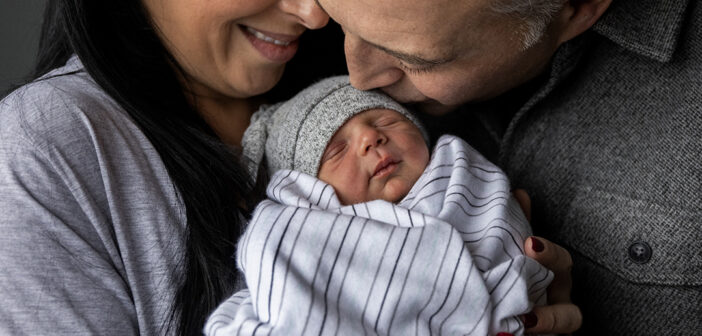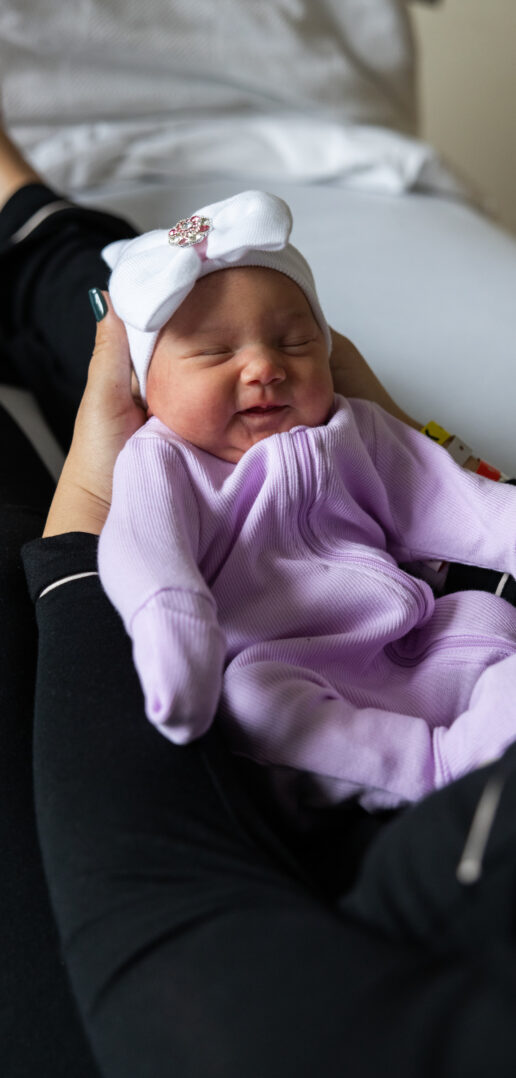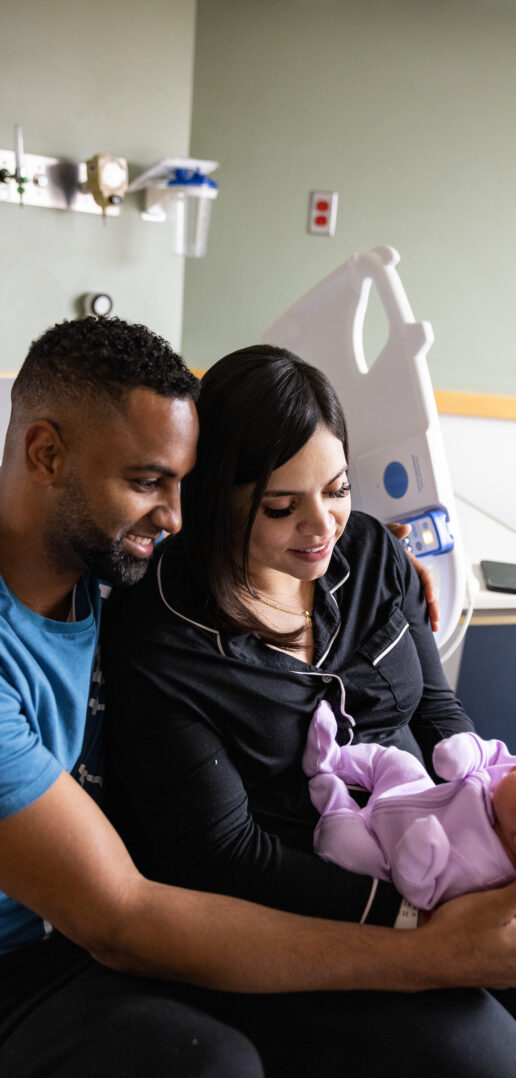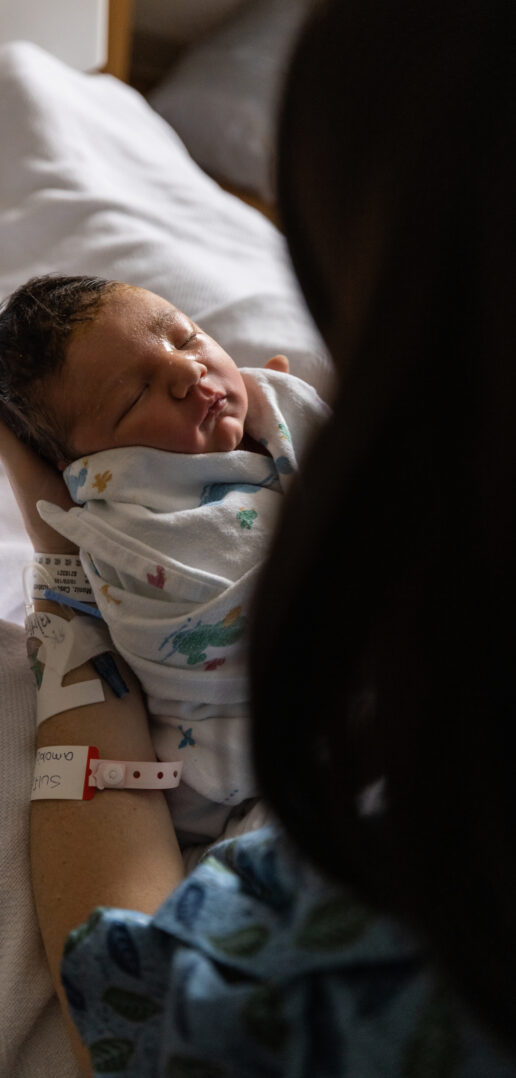Ob/gyn researchers do much more than basic and translational science. Investigators in the Program in Women’s Oncology, for example, study issues related to survivorship and quality of life, like financial toxicity. “The trial is basically looking at the role of upfront financial counseling and its benefits to patients,” DiSilvestro says. “Maybe knowledge is power.”
Emily Miller, MD, MPH, the director of the Division of Maternal Fetal Medicine, is investigating how to integrate mental health care into obstetrics. Primary care practices have used this approach, known as the collaborative care model, for decades, she says.
“Mental health hasn’t historically been included in our training in obstetrics,” says Miller, an associate professor of obstetrics and gynecology. Meanwhile, “primary care doctors have this longitudinal relationship for years and years, ideally, with their patients. In an obstetric setting, it’s a pretty rapid turnover.”
Pregnancy and postpartum are known risk factors for mental health conditions, so screening is recommended for all pregnant patients. And while it’s “very much in the purview of an obstetric clinician to support” care for mental health conditions, Miller says, they usually have to refer patients to outside providers. “We’ve learned that one in 10 people referred out actually makes that connection,” she says. “That’s a huge drop-off.”
Some people aren’t treated because they’re reluctant to report depression or anxiety—perhaps believing them to be a normal part of pregnancy, or fearing judgment. But Miller says that about half of patients who do signal depressive symptoms don’t even get a referral. She’s also found that Black patients are more likely to be screened for perinatal depression than are white patients—yet are less likely to receive a recommendation for treatment.
“There’s no reason that race should influence whether you screen or not, when screening is universally recommended,” Miller says. “I think the only logical explanation is that implicit biases lead us to perceive a population as more at risk for mental health conditions.”
In her research, Miller has shown that collaborative care models “dramatically” reduce many of these disparities. The cornerstone is a care manager, who could be a psychiatric nurse, licensed clinical social worker, or other health professional trained in perinatal mental health as well as health equity and trauma-informed care, she says. When a patient screens positive for depressive symptoms, rather than referring them to another practice, the ob/gyn effectively sends them down the hall to the care manager, who can do additional assessments, make diagnoses, deliver psychotherapy, and offer evidence-based medication guidance to the clinician.
“We make sure that everybody is doing better by tracking symptoms, and then having weekly meetings where we discuss everybody who’s not doing better,” Miller says. People who need more resources get more resources, until remission is achieved.
Collaborative care models also take some work off the plate of ob/gyns. “Obstetric clinicians want to do the right thing. We want to be able to provide this care, we want to screen, we want to talk about it. But we’re asked to do a whole heck of a lot in 15 minutes,” Miller says. She began studying the integration of mental health into obstetrics during her MFM fellowship, when a patient with HIV died shortly after giving birth.
“She passed away from HIV-related complications. But truthfully, those HIV-related complications were because of untreated major depressive disorder and severe anxiety disorder,” says Miller, whose research at the time focused on pregnant and postpartum people with HIV. “It made me realize that I could learn all of the biology of antiretrovirals and all of the drug interactions and pharmacokinetic changes, but none of it really mattered if we weren’t holistically taking care of the person in front of us.”
In her dream world, every ob/gyn practice would have seamlessly integrated mental health care. There would be bridges between outpatient clinics and hospitals, and even to pediatricians after a baby is born, when “the birthing person is kind of an afterthought” yet is at risk for postpartum depression.
“If we could de-silo our care, we could provide better care,” she says. “So that’s the hope and dream, but, you know, give me a little bit.”
If such interdisciplinary, interconnected care models come about, it will likely be the work of current physicians-in-training, who aren’t afraid to ask why, or to push for systemic change. Miller, who came to Brown from Northwestern in July, is already enamored of the ob/gyn residents and fellows here.
“How they approach care and are so attentive to social determinants… they are champions for their patients. And that goes from the bedside to the capitol, and changing policies,” she says. “Kudos to Dayna.”
Dayna Burrell, MD, an assistant professor of obstetrics and gynecology, has worked to center the ob/gyn residency program around a vision of health equity since she became its director in 2018. A key part of that is diversifying the workforce, she says.
“If there is concordance between patients’ and providers’ shared characteristics, including race and ethnicity, there is a higher level of satisfaction with care and greater compliance with care, which can lead to better outcomes,” Burrell says, citing data from the Association of American Medical Colleges.
Achieving the goal of a diverse workforce can start with the residency program, she says. Brown’s program—like many across the nation—uses a “holistic review process, where you actually look at somebody’s lived experiences … that they’ll contribute to the program, the career, the specialty,” as well as their passions. This approach takes the focus off traditional metrics like board scores, because, for example, “an applicant may have higher scores because they had the privilege of extra time and support,” she says.
Applicants often write in their personal statements about their commitment to health equity, social justice, and reproductive rights—and the curriculum, over time, has moved to embrace those priorities. “I think that we’ve always valued diversity and diversity of thought here,” says Star Hampton, MD, the former vice chair for education in the Department of Obstetrics and Gynecology. Now, she says, the demand for social justice and advocacy training feels “more urgent.”
In 2019 the department launched a new curriculum that formalized the focus on diversity, equity, inclusion, reproductive justice, and advocacy within the core didactics. Burrell says they’re evaluating the curriculum now, “and seeing how it should evolve and change. … Talks [about]unconscious bias and upstander training and allyship are all valuable. But I think a lot of the residents are ready for, OK, what’s next? How do we apply that to our patients and community?”
Residents treat many patients who are under- or uninsured and from underrepresented, underserved populations, Burrell says—and they come to Brown specifically for that training. “The education piece of that is the importance of acknowledging how somebody’s life experiences may contribute to how they perceive care in a hospital setting,” she adds. That includes training in trauma-informed care, and didactics that explore forced sterilization of women of color and other instances of racism in the not-so-distant history of ob/gyn in the US.
“All of the health inequities and disparities that have existed in our system have inherently impacted how our patients perceive health care,” Burrell says. “It needs to be intricately woven into our residents’ education and, honestly, our faculty development to ensure that we’re doing everything we can to provide more equitable health care for every patient we see.”
That’s a future Burrell can envision, thanks to the young doctors she teaches every day. “The residents that we work with are incredibly inspiring human beings,” she says. “If we, as faculty, take a step back and listen to our trainees, then we also will be better providers for it.”
Tuuli extols Burrell’s leadership in diversifying the ob/gyn workforce; the current first-year residency class is “one of the most diverse Brown has ever had,” he says. On the faculty side, search committees designate a member who watches for implicit bias in the hiring process, and Women & Infants and Brown collaborate closely to ensure departments’ commitment to diversity. “With those efforts, we’ve actually made quite a bit of progress,” Tuuli says; recent hires have identified as LGBTQ, Black, and Asian, for example.
“We’ve been lucky—” He pauses. “It’s not luck. It is intentionality that attracted a diverse pool.” That hasn’t fully translated, yet, to nursing and other hospital staff, he admits: “There’s still a lot of work to do. No time for complacency.”
Providers are bringing intentionality to patient care with new practices like examining individual cases for bias. Hampton—who is now the senior associate dean for medical education at the Medical School, and continues to see urogynecology patients at Women & Infants—says during morbidity and mortality rounds, providers now ask, about every single case, whether bias may have affected the outcome. That might mean differential treatment due to someone’s race or ethnicity, or a language barrier, or a lack of insurance that delayed care.
“We examine the literature, and then superimpose it on the case and try to understand, was there something we could have done differently?” Hampton says. When the department implemented this practice in 2020, they did not want to pick and choose “health disparity cases,” she says, “because that totally silos out these issues, and these issues are not siloed issues. They are integral to everything we do.” She adds: “That’s really what I’m looking for in our overall medical school curriculum, is integrating DEI into everything as best we can.”
While Hampton says adding a bias review to morbidity and mortality rounds was intended as a “self-reflection exercise,” it has yielded some changes. For example, Burrell writes in an email, “this approach has helped to increase the use and documentation of interpreter services in patient care.” In fact, Tuuli says, the hospital has more than doubled the number of in-person translators and is employing more interpretation technology.
But there is only so much hospitals and health systems—let alone individual providers—can do to alleviate health disparities. While institutions can mandate implicit bias training and hire more interpreters, lack of insurance or transportation are more difficult to tackle. Tuuli mentions one recent initiative, to give free blood pressure cuffs to patients at high risk for postpartum hypertension, who are disproportionately Black and brown and need frequent blood pressure checks. The hospital hired a nurse practitioner and community health worker to facilitate the program, he says. “That’s a concrete step,” he adds, but “a comprehensive effort would take, frankly, a lot more funding.”
That’s why advocacy is becoming more and more crucial to the ob/gyn profession. Women & Infants providers have spoken out on a range of issues, from abortion rights to over-the-counter contraception access to insurance coverage for doulas. And with the State House so close, “compared to other states, it’s very feasible for our residents to be involved on a legislative level,” Burrell says. Faculty and residents also have traveled to Washington, DC, to lobby Congress to protect reproductive rights.
The Supreme Court’s reversal of Roe v. Wade in June underscored the danger in resting on one’s laurels, believing a problem is solved. “I always say it’s super dangerous when you think that you’ve gotten to the end of this work, because that doesn’t happen,” Hampton says. “We’re not done with equity for women. …As soon as we think that, we’re just going to go backwards.”
So she is “super excited” about the mindful steps forward the ob/gyn department is taking, with its intentional focus on diversity, health equity, and advocacy in everything it does. “More can always be done,” Hampton says. “I’m just excited to see it keep going.”









